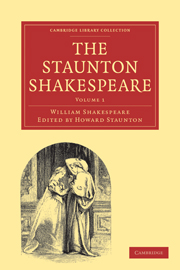Book contents
- Frontmatter
- Contents
- PREFACE
- SOME ACCOUNT OR THE LIFE OF SHAKESPEARE
- SHAKESPEARE'S WILL
- PRELIMINARY MATTER IN THE FOLIO OF 1623
- THE ADDRESS TO THE READER
- COMMENDATORY VERSES
- ADDENDA AND CORRIGENDA
- THE TWO GENTLEMEN OF VERONA
- LOVE'S LABOUR'S LOST
- THE COMEDY OF ERRORS
- ROMEO AND JULIET
- THE TAMING OF THE SHREW
- KING JOHN
- A MIDSUMMER NIGHT'S DREAM
- THE MERCHANT OF VENICE
- KING RICHARD THE SECOND
- THE FIRST PART OF KING HENRY THE FOURTH
- THE SECOND PART OF KING HENRY THE FOURTH
- THE MERRY WIVES OF WINDSOR
- MUCH ADO ABOUT NOTHING
A MIDSUMMER NIGHT'S DREAM
Published online by Cambridge University Press: 29 August 2010
- Frontmatter
- Contents
- PREFACE
- SOME ACCOUNT OR THE LIFE OF SHAKESPEARE
- SHAKESPEARE'S WILL
- PRELIMINARY MATTER IN THE FOLIO OF 1623
- THE ADDRESS TO THE READER
- COMMENDATORY VERSES
- ADDENDA AND CORRIGENDA
- THE TWO GENTLEMEN OF VERONA
- LOVE'S LABOUR'S LOST
- THE COMEDY OF ERRORS
- ROMEO AND JULIET
- THE TAMING OF THE SHREW
- KING JOHN
- A MIDSUMMER NIGHT'S DREAM
- THE MERCHANT OF VENICE
- KING RICHARD THE SECOND
- THE FIRST PART OF KING HENRY THE FOURTH
- THE SECOND PART OF KING HENRY THE FOURTH
- THE MERRY WIVES OF WINDSOR
- MUCH ADO ABOUT NOTHING
Summary
The earliest editions of this drama are two quartos, both published in 1600, one by Thomas Fisher, the other by James Roberts, entitled, “A Midsommer Nights dreame. As it hath beene sundry times publickely acted, by the Right honourable, the Lord Chamberlaine his seruants. Written by William Shakespeare.” Fisher's impression was duly registered at Stationers' Hall; but no memorandum of Roberts's has ever been found: and from this circumstance, and the greater accuracy of its text, the former has usually been considered the authorized version. Yet, strange to say, the player editors of the first folio, when they reprinted the work twenty-three years afterwards, adopted the text of Roberts, and appear to have been unacquainted altogether with the more correct quarto of Fisher.
Malone, in his attempt to determine the chronological order in which these plays were written, assigns the composition of “A Midsummer Night's Dream” to 1594; and Titania's fine description of the unnatural succession of the seasons and the “progeny of evils,” which fairy discords had brought upon the “human mortals,” is singularly applicable to a state of things prevalent in England during the years 1593 and 1594. Strype (Annals, b. IV. p. 211) has printed an extract from one of Dr. J. King's “Lectures upon Jonas,” preached at York in 1594, in which that divine reminds his hearers of the various signs of God's wrath with which England was visited in 1593 and 1594; as storms, pestilence, dearth, and unseasonable weather.
- Type
- Chapter
- Information
- The Staunton Shakespeare , pp. 337 - 388Publisher: Cambridge University PressPrint publication year: 2009First published in: 1858

